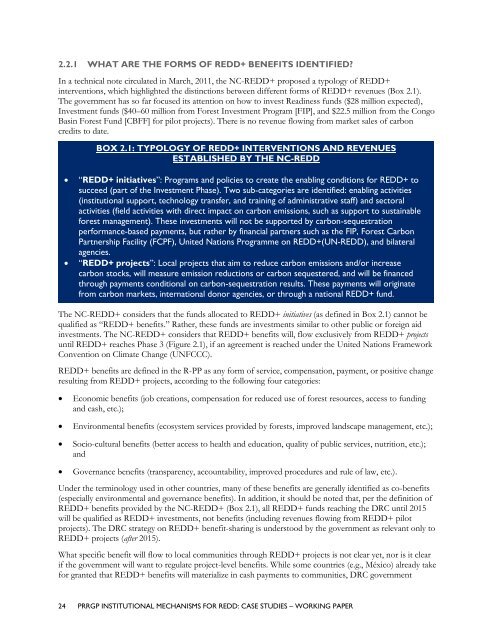Institutional Mechanisms for REDD+ - Case Studies Working Paper
Institutional Mechanisms for REDD+ - Case Studies Working Paper
Institutional Mechanisms for REDD+ - Case Studies Working Paper
Create successful ePaper yourself
Turn your PDF publications into a flip-book with our unique Google optimized e-Paper software.
2.2.1 WHAT ARE THE FORMS OF <strong>REDD+</strong> BENEFITS IDENTIFIED?<br />
In a technical note circulated in March, 2011, the NC-<strong>REDD+</strong> proposed a typology of <strong>REDD+</strong><br />
interventions, which highlighted the distinctions between different <strong>for</strong>ms of <strong>REDD+</strong> revenues (Box 2.1).<br />
The government has so far focused its attention on how to invest Readiness funds ($28 million expected),<br />
Investment funds ($40–60 million from Forest Investment Program [FIP], and $22.5 million from the Congo<br />
Basin Forest Fund [CBFF] <strong>for</strong> pilot projects). There is no revenue flowing from market sales of carbon<br />
credits to date.<br />
BOX 2.1: TYPOLOGY OF <strong>REDD+</strong> INTERVENTIONS AND REVENUES<br />
ESTABLISHED BY THE NC-REDD<br />
� “<strong>REDD+</strong> initiatives”: Programs and policies to create the enabling conditions <strong>for</strong> <strong>REDD+</strong> to<br />
succeed (part of the Investment Phase). Two sub-categories are identified: enabling activities<br />
(institutional support, technology transfer, and training of administrative staff) and sectoral<br />
activities (field activities with direct impact on carbon emissions, such as support to sustainable<br />
<strong>for</strong>est management). These investments will not be supported by carbon-sequestration<br />
per<strong>for</strong>mance-based payments, but rather by financial partners such as the FIP, Forest Carbon<br />
Partnership Facility (FCPF), United Nations Programme on <strong>REDD+</strong>(UN-REDD), and bilateral<br />
agencies.<br />
� “<strong>REDD+</strong> projects”: Local projects that aim to reduce carbon emissions and/or increase<br />
carbon stocks, will measure emission reductions or carbon sequestered, and will be financed<br />
through payments conditional on carbon-sequestration results. These payments will originate<br />
from carbon markets, international donor agencies, or through a national <strong>REDD+</strong> fund.<br />
The NC-<strong>REDD+</strong> considers that the funds allocated to <strong>REDD+</strong> initiatives (as defined in Box 2.1) cannot be<br />
qualified as ―<strong>REDD+</strong> benefits.‖ Rather, these funds are investments similar to other public or <strong>for</strong>eign aid<br />
investments. The NC-<strong>REDD+</strong> considers that <strong>REDD+</strong> benefits will, flow exclusively from <strong>REDD+</strong> projects<br />
until <strong>REDD+</strong> reaches Phase 3 (Figure 2.1), if an agreement is reached under the United Nations Framework<br />
Convention on Climate Change (UNFCCC).<br />
<strong>REDD+</strong> benefits are defined in the R-PP as any <strong>for</strong>m of service, compensation, payment, or positive change<br />
resulting from <strong>REDD+</strong> projects, according to the following four categories:<br />
� Economic benefits (job creations, compensation <strong>for</strong> reduced use of <strong>for</strong>est resources, access to funding<br />
and cash, etc.);<br />
� Environmental benefits (ecosystem services provided by <strong>for</strong>ests, improved landscape management, etc.);<br />
� Socio-cultural benefits (better access to health and education, quality of public services, nutrition, etc.);<br />
and<br />
� Governance benefits (transparency, accountability, improved procedures and rule of law, etc.).<br />
Under the terminology used in other countries, many of these benefits are generally identified as co-benefits<br />
(especially environmental and governance benefits). In addition, it should be noted that, per the definition of<br />
<strong>REDD+</strong> benefits provided by the NC-<strong>REDD+</strong> (Box 2.1), all <strong>REDD+</strong> funds reaching the DRC until 2015<br />
will be qualified as <strong>REDD+</strong> investments, not benefits (including revenues flowing from <strong>REDD+</strong> pilot<br />
projects). The DRC strategy on <strong>REDD+</strong> benefit-sharing is understood by the government as relevant only to<br />
<strong>REDD+</strong> projects (after 2015).<br />
What specific benefit will flow to local communities through <strong>REDD+</strong> projects is not clear yet, nor is it clear<br />
if the government will want to regulate project-level benefits. While some countries (e.g., México) already take<br />
<strong>for</strong> granted that <strong>REDD+</strong> benefits will materialize in cash payments to communities, DRC government<br />
24 PRRGP INSTITUTIONAL MECHANISMS FOR REDD: CASE STUDIES – WORKING PAPER

















